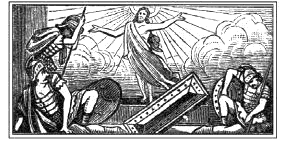
| Contents | Caelestis aulae Nuntius The Messenger from God's High Throne |
BVM |

The author of this hymn is Fr. Augustine Thomas Ricchini (1695-1779). A native of Cremona, Italy, he held several ecclesiastical offices and was a friend of Pope Benedict XIV. Fr. Ricchini first held the office of the Secretary of the Congregation of the Index, and then was the Master of the Sacred Palace. He was also an adviser to the Master General of the Dominicans from 1759 to 1778. This hymn, along with its three companion hymns, In monte olivis consito, Iam morte, victor, obruta, and Te gestientem gaudiis are the hymns from the Roman Breviary for the Feast of the Most Holy Rosary (Oct. 7). The hymns were composed by Fr. Ricchini in 1757 and first appeared in the Dominican Breviary. Later, when the present Office was approved for the Universal Church in 1888 by Pope Leo XIII, these four hymns were added to the Roman Breviary. In the current Liturgia Horarum, the only surviving hymn for the feast is now Te gestientem gaudiis, the other three having been deleted. The Feast of the Most Holy Rosary itself actually goes back to Pope Saint Pius V, who established this feast on the anniversary of the naval victory won by the Christian fleet at Lepanto over the Turkish fleet on 7 Oct., 1571. The victory is attributed to the intercession of the Mother of God, whose aid was petitioned through the prayers of the Rosary before the battle. The celebration of this feast day is an invitation to all to meditate upon the mysteries of Christ, following the example of the Blessed Virgin Mary, who was so singularly associated with the incarnation, passion, death, and glorious resurrection of her Son, the Son of God. The subject of all four hymns are the fifteen mysteries of the Rosary. The first three hymns deal with each set of Mysteries: the Joyous, the Sorrowful, and the Glorious. The fourth hymn is a short summary of the first three hymns. This, the first hymn of the series which is used in the Roman Breviary for first Vespers, deals with the Joyous Mysteries: The Annunciation (Lk 1:26 ff), The Visitation (Lk 1:36, Lk 1:38 ff), The Nativity (John 1:1), The Presentation (cf Lev 12:8, Num 18:16, Lk 2:24), The Finding in the Temple (Lk 2:46).
|
| CAELESTIS aulae Nuntius, arcana pandens Numinis, plenam salutat gratia Dei Parentem Virginem. |
THE Messenger from God's high throne his secret counsel making known hails Mary, child of David's race, God's Virgin Mother, full of grace. |
| Virgo propinquam sanguine matrem Ioannis visitat, qui, clausus alvo, gestiens adesse Christum nuntiat. |
The Mother Maid with joyous feet her friend, John's mother, goes to greet; he, stirring in the enclosing womb, declares that Christ his Lord has come. |
| Verbum, quod ante saecula e mente Patris prodiit, e Matris alvo Virginis, mortalis Infans nascitur. |
The Word, who ere the worlds began, from God the Father's thought forth ran, of Mary, Virgin undefiled, for us is born a mortal child. |
| Templo puellus sistitur, Legique paret Legifer, hic se Redemptor paupere pretio redemptus immolat. |
Christ to the Temple courts they bring; the King's own law subjects the King; the world's Redeemer for a price is there redeemed, our sacrifice. |
| Quem iam dolebat perditum, mox laeta Mater invenit ignota doctis mentibus edisserentem Filium. |
The joyful Mother finds once more the Son she mourned as lost before; while doctors by His speech were shown the mysteries they had never known. |
| Iesu, tibi sit gloria, qui natus es de Virgine, cum Patre, et almo Spiritu, in sempiterna saecula. |
All honor laud, and glory be, o Jesu, Virgin-born to Thee; all glory, as is ever meet, to Father and to Paraclete. |
| Latin text from the Roman Breviary, translation by Alan G. McDougall (1895-1964). |
<- Prev |
Next-> |
